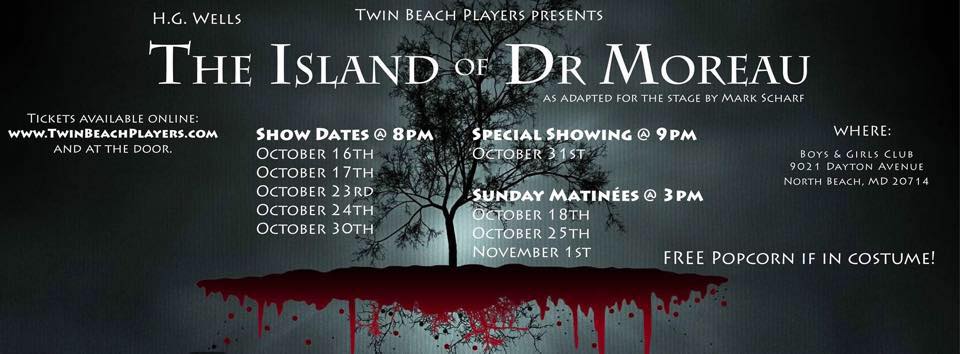Everything in existence takes its color from the hue of our surroundings. When the hue of your surroundings is shrouded in mystery and tingling chills the resulting artwork can be quite chilling this time of year. Debuting as a world premiere at The Twin Beach Players, The Island of Doctor Moreau as written and adapted by Baltimore-based playwright Mark Scharf arrives just in time for the spooky shades of autumn. In a TheatreBloom exclusive interview we sit down with Mark to discuss the inner musings of his new work.
Thank you for sitting with us once more. Won’t you remind us of who you are and where you’ve been?
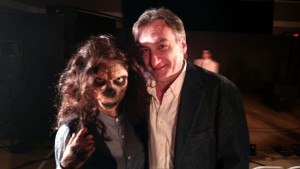
Mark Scharf: Good morning, this is Mark Scharf — playwright and actor, and teacher sometimes. Let’s get the teacher bit out of the way really quickly; last semester I taught a playwriting class at Howard Community College. They offered me this semester but the times just didn’t work out. As an actor, I was busy this year. First it was Born Yesterday, I was a replacement actor. And then I was in Commander. I was a replacement actor there too. Both at Vagabond Players. And coming up I’ll be playing Editor Webb in Our Town, also at Vagabond Players, so I’m currently working on my New England accent, which I hope doesn’t sound like a Pepperidge Farm ad or Katharine Hepburn in drag. And this is going to sound pretentious— you know it’s my favorite word— but playwriting is an extension of acting to me. I’m looking forward to Our Town, I’ll be working with Eric (Eric C. Stein, Director of Our Town) who I worked with in Art back in the fall a year ago. I’ve always wanted to do Our Town; I’ve always admired that play. A lot of people think it’s this smooth cotton candy confection. It’s not. It’s haunted me. The scene at the end with the black umbrellas and then she appears? I still get chills talking about it. I’m really looking forward to that.
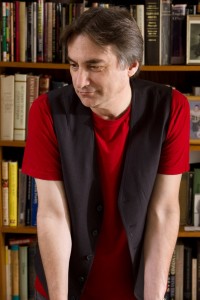
As a playwright, back in January my play Fortune’s Child went up at Baltimore Theatre Project. I’ve had other productions other places, but locally? Well my adaptation of Frankenstein is opening with Attic Productions in Fincastle, Virginia the same night as The Island of Doctor Moreau opens at Twin Beach Players. I also have a staged reading of my newest work The Quickening, which is happening on Thursday October 29, 2015 at Spotlighters Theatre. That’s part of the Dramatist Guild Baltimore Footlights 2015/2015 Reading Series. That play also had a partial reading at the Baltimore Book Fair sponsored by the Maryland State Arts Council because it won for me a Maryland State Arts Council Individual Award in playwriting this year. I was very happy about that. It also had a reading of the first act at the Comparative Drama Conference back in March, in Baltimore. Chelsea Dove, who directed me in Commander, has directed all of the readings of that project so far. It’s been really nice keeping her on the project. We have an ease of communication and I really admire what she does. She’s “scary good.”
Can you talk a little bit about how this adaptation came into existence? It’s my understanding that The Twin Beach Players commission you to write them a Halloween-style adaptation?
Mark: The president of The Twin Beach Players is a gentlemen who I worked with in Washington DC when I first came to DC a long time ago, Sid Curl. Before Sid took over at Twin Beach, I had submitted something to some folks down there, and a previous incarnation of the Twin Beach Players produced my play The Whispers of Saints. And frankly it was one of the best damn productions of it that I had ever seen. I walked in and I couldn’t believe it. The set was marvelous and the acting was amazing. It was the best damn production of it that I had seen and I’d seen it in New York, and there had been a BPF (Baltimore Playwright’s Festival) production that was very good, but this one was impressive. That put me on their radar.
Then when Sid came in, they produced my comedy Keeping Faith. Then Sid talked to me about their “Halloween slot.” They like to do something related to the holiday and involve as many people as possible including kids, and still be something that you can bring kids to and make into an event. I looked at the usual suspects, if you will, and it just seemed to me that there weren’t a lot of adaptations of Frankenstein out there. Of course, at that moment there was one opening in London, but I went ahead with it. There are 8,000 adaptations of Dracula, and dozens more of Doctor Jekyll and Mister Hyde. I had never adapted anything before.
I stuck to the book. Here you have Mary Shelley, 18 years old and she’s written this beautiful thing that still lasts today. I made a few small changes in that I cut a subplot about the maid being framed for murder. The main challenge was the end of the book, which is basically a chase across the tundra. I showed the adaptation to Sid, and he liked it, so they did it. It was very, very successful down there. Subsequently, it was published by Pioneer Publishing and it gets done a lot. I think it’s the one of my published works that gets done the most. There’s been eight productions this year.
That started me on the path. The next Halloween I said to Sid, “why don’t we do Sleepy Hollow?” Again I stuck to the story and went with that. After seeing the way they handled Frankenstein I had an idea of how they handled casting and resources. I had written another ghost story but Sid said it didn’t have enough characters in it. My plays are usually small casts and simple sets, but this theatre company wants boatloads of people. And that is wonderful to have that opportunity to write something like that knowing that it’s going to get to go up. Having already done Frankenstein for them I was able to keep in mind what kind of atmosphere they were working with in the space with the risers and the scrims and all he could do technically. So I adapted Sleepy Hollow for them, and then it was picked up by a different publisher, Brooklyn Publishers.
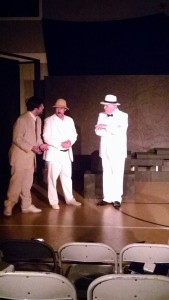
That was last year. He started talking to me about this year and I did not want to tackle something that’s been done to death. So I was looking around and I love H.G. Wells. There are three or four film adaptations of Moreau, but only one other play that I could find. Hollywood felt like there was a narrative hole in the story where there needed to be a love interest. All of the film adaptations have added a love interest character. The 1932 film, Island of Lost Souls added two women. They have a fiancée for Edward as well as the Panther-Woman. Now in my version it’s Puma-Woman because it’s Puma-Woman in the book. But it’s Panther-Woman in the movie. Panthers are black and sleek and sexy and I think that was part of the thrust of 1932 because of the fear of race mixing. That was the underlying notion, having sex with “the other.” The subplot was added and the actual through-line was that Moreau was taking advantage of Edward Prendick being there to see if his creation, his Panther-Woman, was really human. If she was attracted to Edward then she was really human and he could get the two of them to mate and that would confirm his theories.
What is your turnaround for this sort of script?
Mark: I go away and write it. Because it’s an adaptation it doesn’t take me quite as long as an original work because I’m not making decisions about plot. One of the things that tickled me is there is dialogue in my adaptation where Edward asks M’ling, “Where are you from? Where’s your home?” And in the 1932 movie that character has almost exactly that same conversation with the Panther-Woman. So that surprised me, but at least I was on the right trail.
Had you read the book?
Mark: Yes. I worked directly from the book.
But had you read the book before you started the project?
Mark: No. That’s one I had not read.
What are you adapting for them next season?
Mark: I’m actually not adapting for them next season, Sid said he’s going to give me a break and they’re going to do The Bad Seed. It’s a play about a little girl who looks so sweet and innocent but she’s a killer. She’s eight— or maybe she’s ten— a pre-teen murderer. She gets away with it because no one could possibly think that this sweet little girl is killing people. Why does a ten year old girl feel the compulsion to murder somebody? Is it bad wiring? It makes you wonder.
What is it like for you when you are working an adaptation versus working a play of your own original creation? I know to some extent the process must be similar.
Mark: Well it’s similar in that I am creating dialogue, but when I’m writing for myself it’s all coming out of my own head. I’m not thinking out loud about the process in a way that I can even articulate to you. It’s just occurring. I go into a zone. I’m not questioning where things are coming from. Stuff occurs to me and I go in that direction. For me, plot comes out of character, and character determines everything. It determines what kind of person they are and what they are facing and how they are going to view it and deal with it. When it’s obvious to the audience that a character is the playwright’s mouth then you’ve lost them. When I go to plays I don’t want to be preached to and I don’t want to be aware that there is a playwright behind what I’m seeing. If somebody is mechanical and is just moving around like chess pieces on a board it’s unnatural, it’s inorganic. I hate that word, organic, but I can’t think of a better one. It sticks out. I try very hard to keep that from happening.
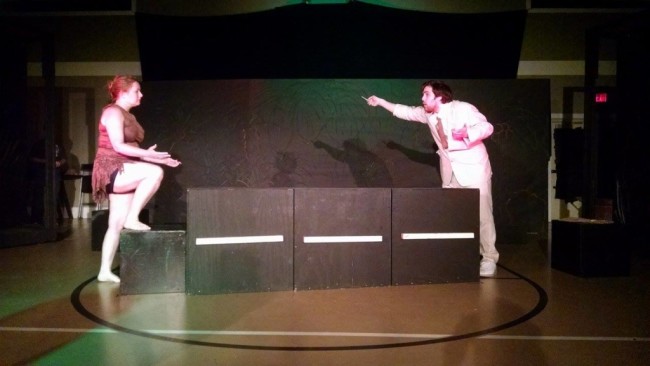
When I’m working on an adaptation I read the book. Sometimes more than once and often during the second read through I start thinking about how I’m going to do it on stage. Sometimes the more ground rules you have the more actual freedom you have. With these folks, I’m aware of where they’re going to be performing and what sort of resources they have access to in regards to costumes, sets, and makeup and that informs the process. I knew I would have a range of actors in both experience and age. In the book there are more gender assignments, Ape-Man, Wolf-Woman. So I just said creature; it’s an Ape-Creature, it shouldn’t make any difference. I am particularly impressed with the young lady playing M’ling (Melly Byram.) I went to an early rehearsal and saw that she had made clear choices. She is one of my favorites.
Writing an adaptation raises questions. Do I need a framing device? How am I going to get certain things across to the audience? I had these questions available to me and used them to tell this story. When I did Sleepy Hollow I used Washington Irving as the framework. Here we are, this is the reality and I’m telling you a story. I really stuck to the book. I keep saying that but it is important to me that when you adapt something you try to stick to the author’s original intentions as much as possible and not screw with it by adding characters and unnecessary plotlines like you have to fix it. There’s a reason the damn things has survived for over 100 years. It’s the same thing with Frankenstein. There’s no Igor in the book.
The Island of Doctor Moreau felt timely to me. Right now with genetically modified food and people arguing over GMOs and cloning and everything else, it just felt right. The other thing about these three adaptations that I’ve done is that all of them are in the public domain so I didn’t have to worry about getting rights or permission. But with adaptations it’s all about sticking to the original story. I actually can’t wait to see the production to see if it matches what I have going on in my head. I tried to write this with their strengths in mind and I did write more suggestive blocking for this. I don’t generally write a lot of stage directions but stuff occurred to me in this one.
What would you say is the biggest challenge of writing an adaptation?
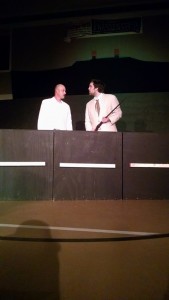
Mark: Trying to impart another writer’s voice and still include yours without destroying or tainting that other voice. Trying to give the audience the experience of that original voice that original intent of what’s going on while still bringing your own voice to it. H.G. Wells had so much going on in this book, so many opinions about the English aristocracy and how useless gentlemen were and he has satirical views of established religion. All of those things are interesting academically but on stage you need to tell a story that holds people’s interests. Trying to successfully maintain H.G. Wells’ voice was the biggest challenge for me. I tried to incorporate as much of the original dialogue as possible. This one is fairly dialogue heavy in the monologues. There’s a whole chapter of Moreau just pontificating and you know that’s going to be absolutely deadly on stage. I tried to collapse things down but he also does interesting things theatrically.
The idea of pain in this story is very important. Wells had actually written that passage where Moreau stabs himself in the thigh to show Edward that we share pain with animals. So when you’re making hybrids, or turning animals into humans, what is it that we can share with them? It’s the suffering that seems to be a universal shared feature. But I think it’s beyond that. What does it mean to be human—
What do you think that means, Mark? To be human?
Mark: To be self-aware and to have empathy. For me the definition of evil is a lack of empathy. Moreau lacks empathy. He’s playing God. He’s cold and clinical. He’s a vivisectionist. He’s operating on these animals without anesthetic in the house of pain. It’s all part of his control mechanism. He gives them larynxes so they can speak, he forms their claws into hands, and tries to make them into humans. Moreau believes that he’s just speeding up the evolutionary process. I think he believes that every mammal is eventually going to become what we are and he’s just speeding it up. That’s a theme that’s more pointed out in that Island of Lost Souls. If you’re going to watch one of the movies, find that 1932 Island of Lost Souls with Charles Laughton and Bela Lugosi. In that version, they say to Edward of the Panther-Woman. “She’s pure Polynesian.” And then they try to see if they’ll mate. And then when things go wrong she’s able to cry. That was extremely important because that showed she was human.
Did I answer your question? Being human is to have empathy not just for your own self-interests and your own feelings but for other people and animals.
What has working on this adaptation taught you about yourself as a writer?
Mark: That I should stick to my original instincts and not write so many stage directions.
What is it that you are hoping people are going to take away from this experience? Why should they come see the show?
Mark: On one level I want people just to have a good time. But from the show itself, again thinking about what it means to be human and becoming that— and as corny as it sounds, being the best human you can be— I want people to think about having a connection to other people. People need to be self-aware of the effect you have on others. I want them to think about not relegating other people or other species into little boxes where you can do things to them and it doesn’t matter. We dehumanize our enemies before we go out and shoot and bomb them. It also shares theme that’s in Frankenstein, man’s technological progress. How far is too far? Is there such a thing as too far? What makes this kind of research okay or not okay? Is it the way you conduct it or the end result of what you’re pursuing. Regardless of how altruistic you think you’re being, and I think Moreau sees himself as altruistic because he thinks he’s working for the greater good, but if other people are seeing you as bat-shit crazy, then what does that say?
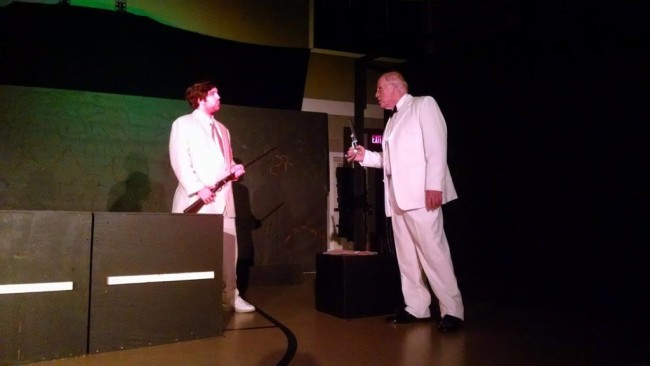
It’s a charming town. It actually used to be a resort town before they built the bay bridge. I love that it’s so close to the water. There’s an adventure waiting for you. If you get there early you’ll see that charming beach town with shops and restaurants and lovely people, and the water — which I deeply love. But in addition to that go to see an adaptation. Go see what I’ve done with a classic. They are extremely supportive and encouraging, I couldn’t ask for a better group of people to be around. I am their playwright in residence. Here is small theatre in southern Maryland who is doing new work in their regular season and taking that financial risk. And people are coming and it’s paying off. It can be done!
The Island of Doctor Moreau plays through November 1, 2015 at The Twin Beach Players in the North Beach Boys & Girls Club— 9021 Dayton Avenue in North Beach, MD. Tickets are available for purchase at the door or in advance online.
To read the review for The Island of Doctor Moreau, click here.

